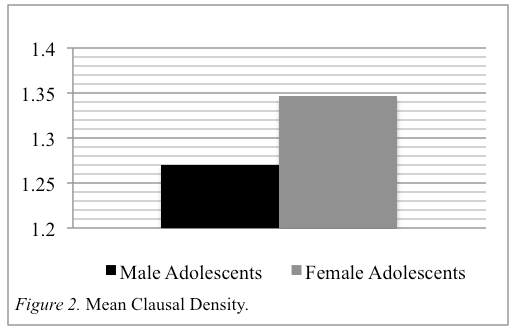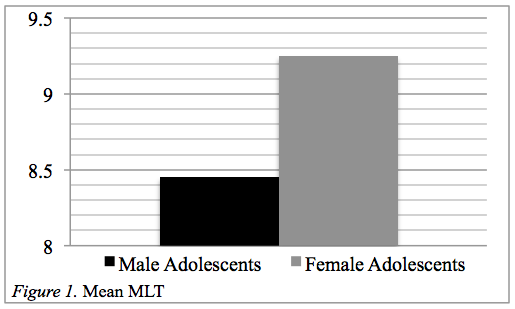Research NoteGender Differences in Syntactic Development Among English Speaking Adolescents
By
2014, Vol. 6 No. 03 | pg. 1/1
IN THIS ARTICLE
KEYWORDS
Numerous studies have reported on the female advantage in language skills. It appears that across many domains of language, female language skills are more highly developed and often more complex than the language skills of their male counterparts. For instance, in a vast study of over 13,000 children in ten different language communities, Eriksson et al. (2012) found girls to be more advanced than boys in language abilities in each language community. Specifically, results showed girls to be ahead of boys in early communicative gestures, in productive vocabulary, and in combining words. Although there existed great variation between the children’s language abilities from community to community, the female advantage persisted throughout. In a similar study, Tse, Kwong, Chan, and Li (2002) set out to determine sex differences in language ability among Cantonese-speaking children. In particular, Tse et al. (2002) focused their efforts on the syntactic domain of language. They analyzed utterances spoken by children ages 3 to 5 during spontaneous play. They found significant sex differences between girls and boys in syntactic development. Girls outperformed boys in mean length of utterance (MLU), some sentence types and structures, and syntactic complexity (Tse et al., 2002). Essentially, sex differences in language development appear to persist across various languages and cultures as well as across the different domains of language. PurposeThis paper is particularly concerned with addressing the discrepancies between males and females regarding syntactic aspects of language. As shown by Tse et al. (2002), there exist apparent differences in syntactic development among 3 to 5 year-old Cantonese-speaking children. It is questionable whether this gap in syntax remains as children grow and age and receive further educational opportunities. Like other aspects of language development, syntactic development is considered to be a lifelong process. Although syntax has been observed to develop most rapidly in the preschool years, it continues to develop, although more gradually, throughout the school years, adolescence, and adulthood (Nippold, Mansfield, & Billow, 2007, p. 179). This paper addresses gaps in the literature regarding syntactic development in adolescence and reports on the syntactic capabilities and discrepancies between English-speaking adolescent males and females. The author hypothesizes that the gap in syntactic ability between males and females will remain into adolescence due to further opportunities for syntactic growth in females resulting from an early advantage in syntax. This idea is explored through collecting language samples from adolescents using the Peer Conflict Resolution task as described by Nippold et al. (2007). Facility of syntax was determined through analysis of the language samples involving measures of syntactic complexity and frequency of subordination.MethodologyParticipantsParticipants included two groups of adolescents ranging in age from 14 to 15 years old with the youngest participant 14 years and 4 months of age and the oldest participant 15 years and 9 months of age. The first group consisted of 3 adolescent boys with a mean age of 15;0. The second group consisted of 3 adolescent girls with a mean age of 14;7. Participants were all freshman in high school recruited from the same public high school. It should be noted that all participants were of similar socioeconomic status (SES) and had similar educational backgrounds. Additionally, each group varied in ethnicity. In the male group, 1 participant identified as Black and 2 participants identified as White. In the female group, 1 participant identified as Black, 1 participant identified as White, and 1 participant identified as Hispanic/Latino. ProceduresSpecific steps were taken in order to obtain language samples from the participants. Essentially, prompts were used for the purpose of discreetly encouraging participants to engage in expository discourse. In order to elicit complex syntax amongst the participants, the Peer Conflict Resolution (PCR) task, as described by Nippold et al. (2007), was utilized. In order to introduce the task, an interviewer explained that problems are common occurrences and that individuals must find ways to solve their problems. The interviewer then read two stories to each participant. The stories illustrated some problem for which participants were expected to generate solutions. After each story, the interviewer asked the participant to retell the story in their own words and to include every detail they could remember about the story in their retelling. Subsequently, the interviewer asked each participant a few questions about each story they had heard. Inquiries included questions such as, “What is the main problem here?” and “Why is that a problem?” The PCR task was used in order to elicit language samples for data collection because it has been shown to be sensitive to the use of complex syntax, and it is an effective tool to elicit expository discourse in older children, adolescents, and adults. The PCR task was used over other tasks/prompts, such as the favorite game or sport (FGS) task, because it has been shown to elicit syntactic complexity to a greater extent than other tasks (Nippold et al., 2007). Language generated from the PCR task was recorded and then carefully transcribed. Each word and utterance spoken by each participant was transcribed, and fragments and mazes were placed in parentheses and excluded from analysis. Language samples were subsequently broken down into clausal components. T-units/independent clauses, adverbial clauses, relative clauses, and nominal clauses were identified in each language sample. Two measures were used in order to assess syntactic development in girls and boys. The first, mean length of T-unit (MLT) is commonly used to measure syntactic development in individuals over 4 to 5 years of age. MLT essentially denotes an individual’s level of syntactic development by describing the number of words spoken per T-unit. A T-unit is a specific unit of linguistic analysis that contains one independent clause and any subordinate clauses or nonclausal structures that are attached to or embedded within it. An independent clause contains a subject and a main verb and is able to stand alone to express a complete thought while a subordinate clause contains a subject and a main verb; however, it must be linked to an independent clause in order to express a complete thought. MLT was calculated by dividing the total number of words in a language sample by the total number of T-units in the same sample. It is important to understand that MLT is a gross developmental index of syntax. Therefore, it logically follows that MLT provides no information on specific structural complexity. MLT, rather than mean length of utterance (MLU), was used as a unit of analysis because MLU as a measure loses validity after age 4 or 5 or after children have acquired the grammar of language (Nippold et al., 2007). Whereas MLU measures the number of morphemes used per utterance, MLT measures the number of words used per t-unit. MLT enables a more accurate assessment of the syntactic ability of adolescents. It is important to note that low MLTs most commonly reflect individual variation in syntactic development rather than a language disorder. This study aims to determine if there is systematic variation between the MLTs of adolescent boys and the MLTs of adolescent girls. The second measure used to assess syntactic development was clausal density, which reflects the syntactic complexity of an individual’s language. Clausal density is a measure that relies on the number of independent clauses a speaker uses versus the number of subordinate clauses the speaker uses. As a whole, clausal density is a direct reflection of the subordination a speaker uses, and the more subordinate clauses a speaker uses, the more complex his/her language is considered to be. The three primary types of subordinate clauses include adverbial clauses, relative clauses, and nominal clauses. Adverbial clauses express condition, time or manner and modify a verb. Relative clauses describe a noun and usually express which one or what kind. Nominal clauses are essentially complement clauses that may act as the subject or object of a sentence. Nominal clauses function as noun phrases. Clausal density was calculated by summing all of the coded main and subordinate clauses in a language sample and by dividing this sum by the total number of T-units produced in the sample (Nippold, et al., 2007). This study aims to determine whether adolescent males or females speak with greater clausal density and, thus, greater syntactic complexity. ResultsAfter calculating the MLT and clausal density of each participant’s language, results were analyzed. Boys’ MLT and clausal density were compared the MLT and clausal density exhibited by girls. Male participants exhibited a mean MLT of 8.45 words. The male with the smallest MLT had an MLT of 8.03 words while the male with the largest MLT had an MLT of 8.89 words. Female participants displayed a mean MLT of 9.249 words. The smallest MLT held by a female participant was 8.9 words, and the largest MLT held by a female was 9.89 words. Therefore, it follows that one may logically conclude that adolescent females ages 14 to 15 display larger MLTs than male adolescents of the same age. A summary of these results may be seen in figure 1. Thus, female adolescents appear to be somewhat more advanced in the realm of syntactic development than males. A noteworthy finding is that the lowest female MLT score is higher than the highest male MLT score. Tse et al. (2002) identified that among 3 to 5 year-old children, girls’ spoken language in the syntactic realm develops more rapidly than boys’. This pattern appears to persist into adolescence according to the results of the MLT measure.
Clausal density, as a unit of analysis, revealed differences between the language used by male and female adolescents as well. As a group, males displayed a mean clausal density of 1.27 with a low clausal density score of 1.23 and a high clausal density score of 1.32. Female participants, on the other hand exhibited a mean clausal density of 1.346. The lowest female clausal density score was 1.29 while the highest female clausal density score was 1.41. Therefore, it may be concluded that adolescent females speak with greater subordination than adolescent males. This is visually illustrated in figure 2. The language of adolescent females is more syntactically developed, as shown by MLT results, as well as more syntactically complex, as shown by clausal density results. Therefore, according to this study, the author’s hypothesis was confirmed, and the female syntactic advantage shown early in life sustained its presence into adolescence.
A key finding worth noting is that the slight age differences between the participants had no observable effects on syntactic ability. For instance, the two 15 year-old participants in the study, a male and a female, performed no better than their 14 year-old counterparts. Additionally, the youngest participants did not perform worse than the older participants. Essentially, among high school freshman students, slight age discrepancies played no causal role in syntactic ability. Additionally, it is necessary to point out that there existed greater variability among female clausal density scores than among male clausal density scores. Male clausal density scores displayed a range of only.09 with the lowest score being 1.23 and the highest score being 1.32, while female clausal density scores displayed a much higher range of .12 and stretched from 1.29 to 1.41. Perhaps further investigation may determine why this is so. Additionally, in this particular study, each female participant used nominal clauses to a far greater extent than any of the other types of subordinate clauses while male participants did not seem to favor a particular type of subordinate clause. Perhaps this is simply a coincidental finding of this particular study, however, further investigation is necessary to determine if this is a commonly found pattern in the spoken language of female adolescents. DiscussionIn accordance with previous studies, this study shows females’ spoken language to be more advanced than the spoken language of males. The present study is particularly notable, however, because it identifies differences in syntactic development among adolescents, a population rarely studied by language development researchers. It now follows to discuss particular factors that may play a contributing role to such differences in language between males and females. Biological DifferencesSome researchers assert that the differences in language ability between the sexes may be attributed to differences in biological makeup. According to Joseph (2000), neurological discrepancies may result as an outgrowth of the process of evolution. Joseph (2000) argues that the female brain has become organized so that both hemispheres engage in some degree of activity when producing or comprehending language (p. 55). In addition, Joseph contends that females display a slightly larger corpus callosum than males, which may enable easier and more efficient interaction between the left and right hemispheres (p. 55). The male brain, on the other hand, is more unilaterally organized and relies primarily on the left hemisphere for language expression and processing. Therefore, perhaps the female brain is more intensively devoted to language than the male brain. The female brain is suspected to have evolved to this capacity due to past practices throughout evolutionary history. Over the course of time, a female’s traditional role involved acting as a mother and domestic caretaker of the home. Both aspects of this role necessitate communicative ability. A mother must communicate with her child and teach her child how to communicate. Domestic activities likely require socio-emotional communication with other women or members of the family. Conversely, traditional male activities, such as hunting, involved prolonged silence over time. Throughout history, a male’s ability to communicate was unimportant and played little to no role in his success (Joseph, 2000, p. 56). Similarly, Vogel (1990) notes that while females champion greater language ability, males have been shown to exhibit greater ability in the field of mathematics and spatial abilities. This too follows suit with an evolutionary perspective, as spatial ability would have been directly related to a male’s success as a hunter and provider. According to this proposition, differences in syntactic ability between males and females may be due to an innate neurological mechanism regarding language ability stemming from the process of evolution. Sociocultural DifferencesA supplementary explanation as to why males and females display different degrees of facility with language pinpoints differences in the way individuals are reared. Essentially, each culture contributes to a process of socialization, which guides males and females toward specific and often divergent gender roles. Such socialization may directly affect the way each gender uses language for communicative purposes. For instance, Clearfield & Nelson (2006) found that American mothers of infant daughters engaged in more conversation with their female infant than mothers did with a male infant. Mothers of sons made more comments and provided more instructions to their children instead of creating conversational opportunities with them. It was also found that mothers socially interact with their daughters to a much greater extent than they do with their sons (Clearfield & Nelson, 2006, p. 134). This pattern of interaction instills the value of conversation and communication in girls, which likely presents as more advanced and complex language development in girls when compared with boys. Receiving fewer opportunities for social interaction, boys may be left with less-developed language abilities. The language advantage experienced by girls early in life may essentially bootstrap language learning in females so that the female advantage may be seen through adolescence and into adulthood. While both the evolutionary and sociocultural perspectives are valid explanations, perhaps the language discrepancies seen between males and females may be best described as a combined result of sociocultural and biological factors. While socialization undoubtedly plays a role in child behavior and development, sociocultural explanations are unable to explain the gender gap in language ability in its entirety. Multiple studies, such as that by Eriksson et al. (2012), have shown female language advantage to be present internationally across different languages and cultures. Different cultures, however, have different expectations of communication among males and females, and gender socialization varies widely across cultures. Regardless of vast contrasts in gender socialization, female language advantage still persists. Therefore, perhaps a complex combination of cultural, social, and biological factors contribute the this study’s finding of greater syntactic development and complexity among adolescent females when compared to their male counterparts. Limitations of this StudyIt is important to caution the generalizability of the findings of this study due to the study’s small sample size, n=6. Had the sample size been larger, the findings would likely have significant real-world implications. Additionally, all of the participants attended the same high school, had similar educational backgrounds, and displayed similar SES as members of the middle-class; therefore, it may not be assumed that the study’s outcomes would hold true for individuals of different SES or individuals with diverse educational backgrounds. The author hopes to expand the study in the future by including more participants and participants from diverse backgrounds. Plans for Future StudyAn expansion of this study in the future is likely so that the study’s findings may become more generalizable. As mentioned above, this expansion would include a larger number of participants as well as participants from diverse SES, diverse educational backgrounds, and diverse race/ethnicity so that the study’s implications may be widely held. Future research hopes to ascertain if adolescent females really do use more nominal clauses than other types of subordinate clauses or if this is just a coincidental finding of the present study. Additionally, future research would aim to determine if adolescent females commonly display greater variability in levels of syntactic complexity than males or if this occurrence was only true for the present study’s participants. In addition, a measure of nonverbal cognition prior to syntactic analysis would be an informative additional component so that the effects of nonverbal cognition, if any, on the difference in syntactic development between adolescent males and females may be ascertained. A measure of nonverbal cognition, such as the Leiter International Performance Scale-Revised, may be used in order to assess nonverbal cognition to determine if the female advantage in syntax is simply do to an advantage in nonverbal cognition or if it is due, as the author suspects, to a female advantage in language skill. Nonetheless, this study addressed an area that had been left unchartered by previous research and made clear the possibility of a distinct discrepancy between the syntactic abilities of male and female adolescents. ReferencesClearfield, M. W., 7 Nelson N. M. (2006) Sex differences in mothers’ speech and play behavior with 6-, 9-, and 14- month old infants. Sex Roles, 54(1), 127-137. doi: 10.1007/s11199-005-8874-1 Eriksson, M., Marschik, P.B., Tulviste, T., Almgren, M., Perez Pereira, M., Wehberg, S., & Gallego, C. (2012). Differences between girls and boys in emerging language skills: Evidence from 10 language communities. British Journal of Developmental Psychology, 30(2), 326-343. doi: 10.1111/j.2044-835X.2011.02042.x Joseph, R. R. (2000). The evolution of sex differences in language, sexuality, and visual-spatial skills. Archives of Sexual Behavior, 29(1), 35. Nippold, M. A., Mansfield, T. C., & Billow, J. L. (2007). Peer conflict explanations in children, adolescents, and adults: Examining the development of complex syntax. American Journal of Speech-Language Pathology, 16, 179-188. Tse, S., Kwong, S., Chan, C., & Li, H. (2002) Sex differences in syntactic development: Evidence from Cantonese-speaking preschoolers in Hong Kong. International Journal of Behavioral Development, 26(6), 509-517. doi: 10.1080/01650250143000463 Vogel, S. A. (1990). Gender differences in intelligence, language, visual-motor abilities, and academic achievement in students with learning disabilities: A review of the literature. Journal of Learning Disabilities, 23(1). Suggested Reading from Inquiries Journal
Inquiries Journal provides undergraduate and graduate students around the world a platform for the wide dissemination of academic work over a range of core disciplines. Representing the work of students from hundreds of institutions around the globe, Inquiries Journal's large database of academic articles is completely free. Learn more | Blog | Submit Latest in Linguistics |




















